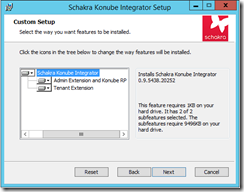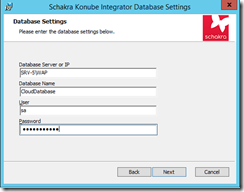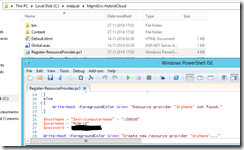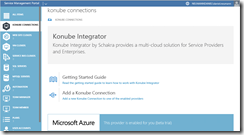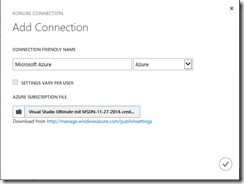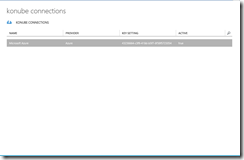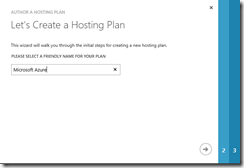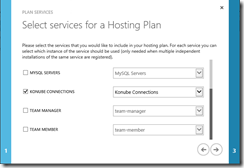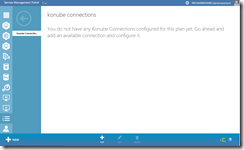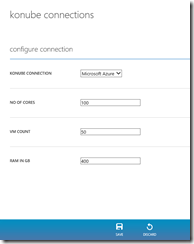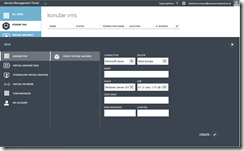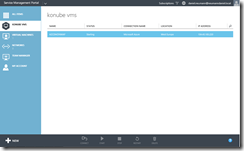The Windows Azure Pack gives you the possibility to provide Azure services out of your own datacenter to your customers or internal business units. The most common services in an on-premises environment are VM clouds and SQL servers. You can also provide your customers with Website clouds, Service Bus clouds and MySQL servers. But when you use Windows Azure Pack you want to leverage the whole Cloud OS story and that’s a hybrid environment. In the current version Windows Azure Pack does not provide a resource provider or any other implementation by itself to connect your Azure subscription with WAP. So the single pane of glass is missing here and it is one of the top five votes on the Azure Pack feedback.
If you would like to start today using Azure out of WAP, then have a look at Konube Integrator. It is a 3rd party resource provider and let you connect WAP with one or more Azure subscriptions. Beside Azure you can also connect WAP with RackSpace and for a future release of Konube Integrator AWS connection is announced.
Now I will guide you through the setup & configuration process of Konube Integrator and will show you what you can do with it today.
To install Konube Integrator start PowerShell or a command prompt as administrator and install the MSI file with msiexec /i KonubeIntegrator.msi. Otherwise the installation will fail.
I’m using the WAP express installation in my lab environment, so both extensions are installed on the same machine. During the setup you have to point to your SQL server for the Konube Integrator database. The SQL authentication option must be enabled on the SQL server and the specified SQL user should have sysadmin rights.
Before you go to the WAP admin portal you have to run the Register-ResourceProvider.ps1. You can find the PowerShell script under C:inetpubMgmtSvc-HybridCloud. Open the PowerShell script end edit the variables $userName and $password.
Don’t use any special characters for the password, us an alphanumeric password instead. Otherwise some unforeseen behaviors can occur. Like you are not able to add a connection to your public cloud service in the WAP admin portal.
After you have executed the PowerShell script login to the WAP admin portal. You will now see the new resource provider extension.
Setting up a connection to your Azure subscription is very easy. Just click on “Add a new Konube Connection to one of the enabled providers”.
Enter the name for the connection and choose the right provider. Here we will use Azure. Because Konube Integrator uses the publishsettings file you do not have to create a certificate by yourself. Go to http://manage.windowsazure.com/publishsettings and download the publishsettings file of your subscription. Upload it and click ok. Afterwards you will now see your connection under Konube Connections. If you have several subscriptions enter the subscription name when you create the connection.
Next step is to create a new hosting plan or assign the service to an already existing hosting plan. We will create a new one.
Before you can use Konube Integrator via the Tenant portal you have to add the connection to the hosting plan.
There you can define the number of cores, the number of VMs and the maximum memory consumption for the connection to Azure.
Login to the Tenant portal and subscribe to the newly created hosting plan.
You can now easily create a new VM in Azure, choose your favorite region, type in a name, choose your image, choose your size and define your administrative account.
As you can see the VM is spinning up in Azure. When the VM is finally deployed you can directly connect via RDP to your VM out of the Windows Azure Pack Tenant portal. That is very nice. But I’m missing some capabilities and will take about it in a second.
My first one is about the images. As you have already recognized you can only choose between three different images, Windows Server 2008 R2, Windows Server 2012 and Windows Server 2012 R2. I would like to see more images e.g. SharePoint, SQL Server and the Linux images.
Then I’m missing the capability to choose the Virtual Network for the Azure VM. From my point of view that is something really important. If I have a S2S VPN connection to Azure for my Hybrid scenarios I want to provide that to my self-service users also via the Tenant portal and for that it must be able to choose the right Virtual Network.
Last but not least VMs that are already provisioned in Azure cannot be assigned to a specific self-service user. That would be really cool. Maybe via a PowerShell cmdlet or otherwise a SQL script that runs against the Konube Integrator database. Another option is to let the user choose from a list of Azure VMs that aren’t assigned to a self-service user. If the VM is assigned to a self-service user they will disappear from that list.
Finally I recommend to tryout Konube Integrator when you would like to provide on-premises and Azure VMs to your self-service users via the WAP Tenant portal.
